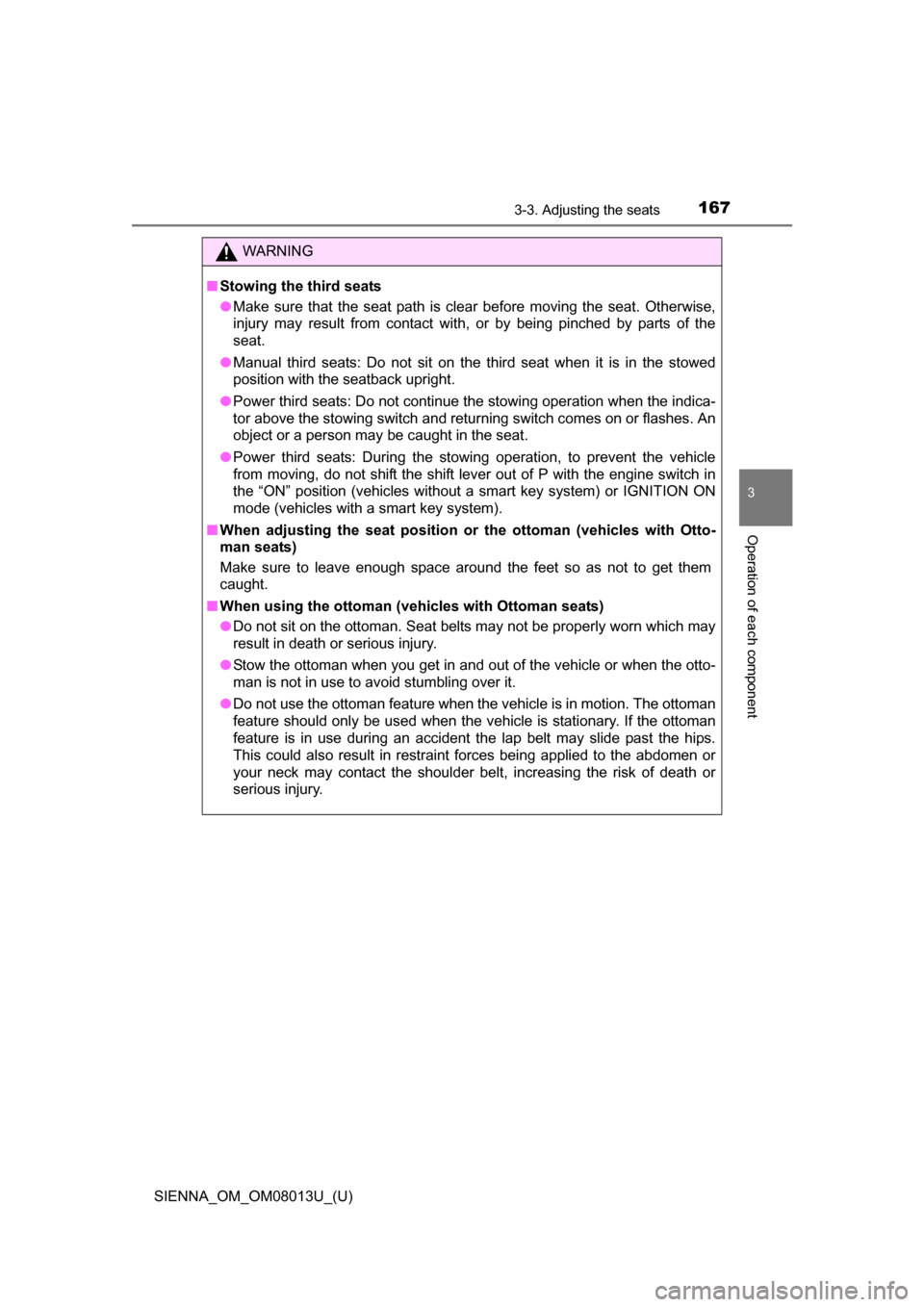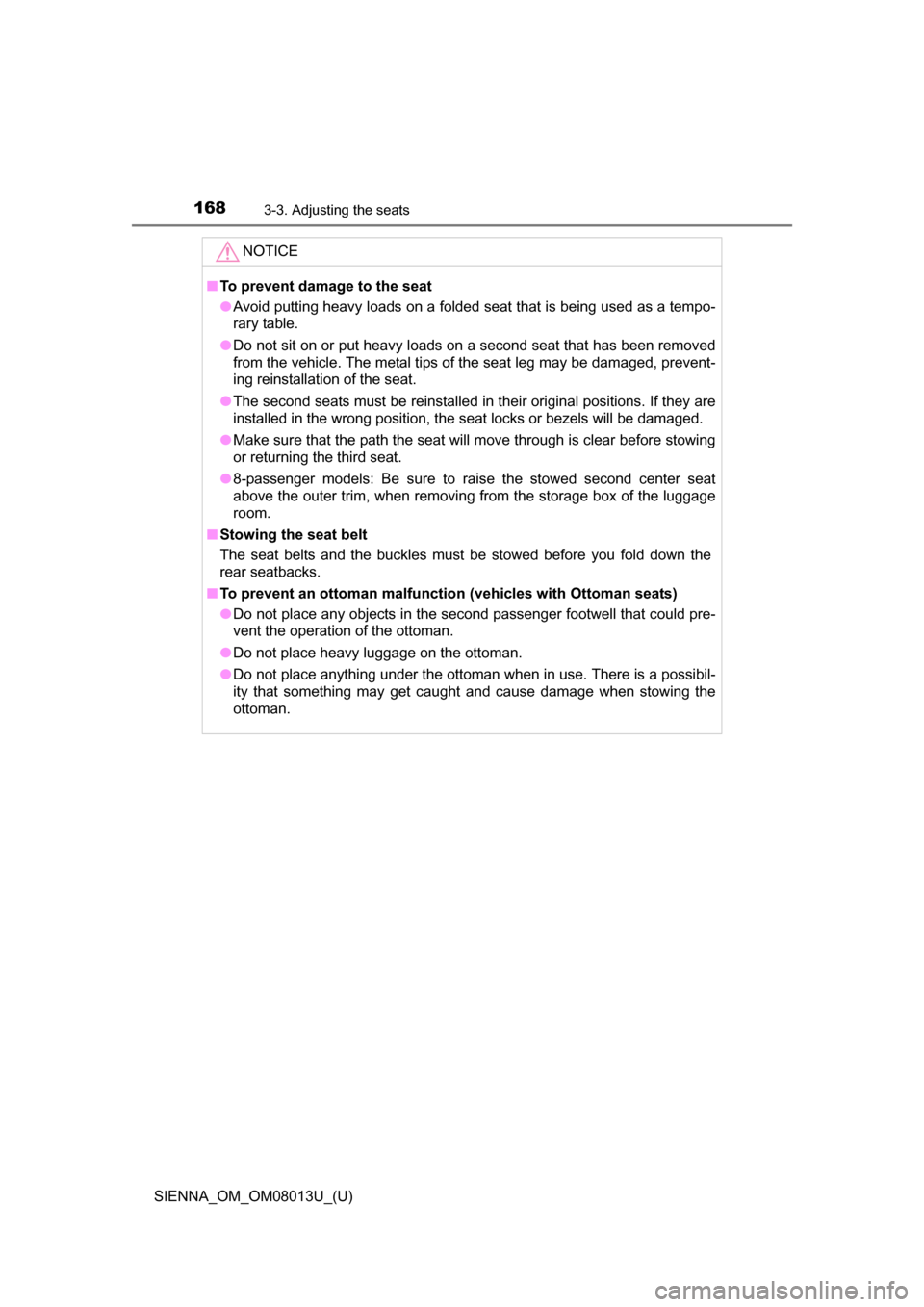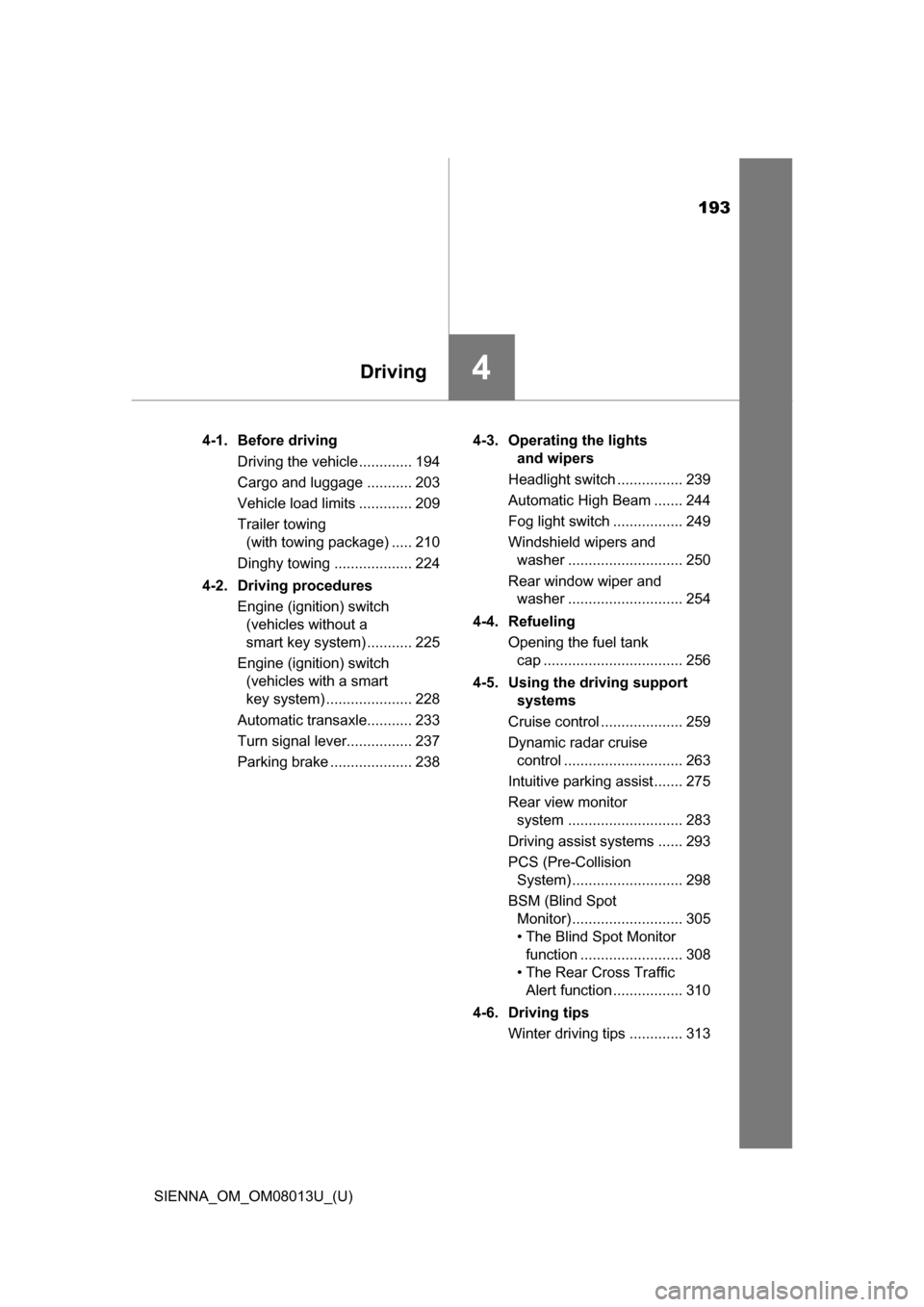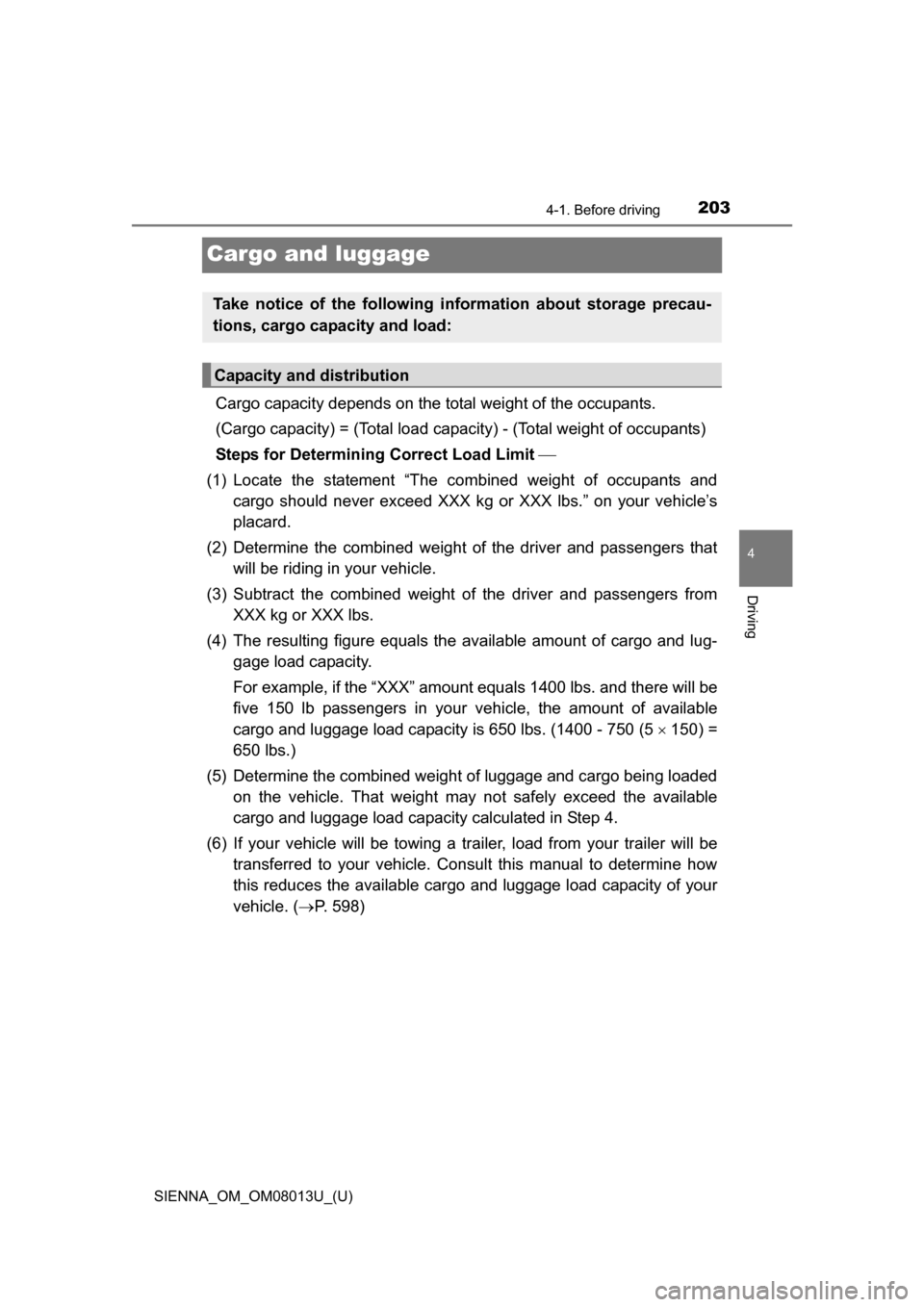Page 167 of 668

SIENNA_OM_OM08013U_(U)
1673-3. Adjusting the seats
3
Operation of each component
WARNING
■Stowing the third seats
●Make sure that the seat path is clear before moving the seat. Otherwise,
injury may result from contact with, or by being pinched by parts of the
seat.
● Manual third seats: Do not sit on the third seat when it is in the stowed
position with the seatback upright.
● Power third seats: Do not continue the stowing operation when the indica-
tor above the stowing switch and returning switch comes on or flashes. An
object or a person may be caught in the seat.
● Power third seats: During the stowing operation, to prevent the vehicle
from moving, do not shift the shift lever out of P with the engine switch in
the “ON” position (vehicles without a smart key system) or IGNITION ON
mode (vehicles with a smart key system).
■ When adjusting the seat position or the ottoman (vehicles with Otto-
man seats)
Make sure to leave enough space around the feet so as not to get them
caught.
■ When using the ottoman ( vehicles with Ottoman seats)
● Do not sit on the ottoman. Seat belts may not be properly worn which may
result in death or serious injury.
● Stow the ottoman when you get in and out of the vehicle or when the otto-
man is not in use to avoid stumbling over it.
● Do not use the ottoman feature when the vehicle is in motion. The ottoman
feature should only be used when the vehicle is stationary. If the ottoman
feature is in use during an accident the lap belt may slide past the hips.
This could also result in restraint forces being applied to the abdomen or
your neck may contact the shoulder belt, increasing the risk of death or
serious injury.
Page 168 of 668

168
SIENNA_OM_OM08013U_(U)
3-3. Adjusting the seats
NOTICE
■To prevent damage to the seat
●Avoid putting heavy loads on a folded seat that is being used as a tempo-
rary table.
● Do not sit on or put heavy loads on a second seat that has been removed
from the vehicle. The metal tips of the seat leg may be damaged, prevent-
ing reinstallation of the seat.
● The second seats must be reinstalled in their original positions. If they are
installed in the wrong position, the seat locks or bezels will be damaged.
● Make sure that the path the seat will move through is clear before stowing
or returning the third seat.
● 8-passenger models: Be sure to raise the stowed second center seat
above the outer trim, when removing from the storage box of the luggage
room.
■ Stowing the seat belt
The seat belts and the buckles must be stowed before you fold down the
rear seatbacks.
■ To prevent an ottoman malfunctio n (vehicles with Ottoman seats)
● Do not place any objects in the second passenger footwell that could pre-
vent the operation of the ottoman.
● Do not place heavy luggage on the ottoman.
● Do not place anything under the ottoman when in use. There is a possibil-
ity that something may get caught and cause damage when stowing the
ottoman.
Page 193 of 668

193
SIENNA_OM_OM08013U_(U)
4Driving
4-1. Before drivingDriving the vehicle ............. 194
Cargo and luggage ........... 203
Vehicle load limits ............. 209
Trailer towing (with towing package) ..... 210
Dinghy towing ................... 224
4-2. Driving procedures Engine (ignition) switch (vehicles without a
smart key system) ........... 225
Engine (ignition) switch (vehicles with a smart
key system) ..................... 228
Automatic transaxle........... 233
Turn signal lever................ 237
Parking brake .................... 238 4-3. Operating the lights
and wipers
Headlight switch ................ 239
Automatic High Beam ....... 244
Fog light switch ................. 249
Windshield wipers and washer ............................ 250
Rear window wiper and washer ............................ 254
4-4. Refueling Opening the fuel tank cap .................................. 256
4-5. Using the driving support systems
Cruise control .................... 259
Dynamic radar cruise control ............................. 263
Intuitive parking assist....... 275
Rear view monitor system ............................ 283
Driving assist systems ...... 293
PCS (Pre-Collision System) ........................... 298
BSM (Blind Spot Monitor) ........................... 305
• The Blind Spot Monitor function ......................... 308
• The Rear Cross Traffic Alert function ................. 310
4-6. Driving tips Winter driving tips ............. 313
Page 203 of 668

203
SIENNA_OM_OM08013U_(U)
4-1. Before driving
4
Driving
Cargo and luggage
Cargo capacity depends on the total weight of the occupants.
(Cargo capacity) = (Total load capacity) - (Total weight of occupants)
Steps for Determining Correct Load Limit
(1) Locate the statement “The combined weight of occupants and cargo should never exceed XXX kg or XXX lbs.” on your vehicle’s
placard.
(2) Determine the combined weight of the driver and passengers that will be riding in your vehicle.
(3) Subtract the combined weight of the driver and passengers from
XXX kg or XXX lbs.
(4) The resulting figure equals the available amount of cargo and lug- gage load capacity.
For example, if the “ XXX” amount equals 1400 lbs. and there will be
five 150 lb passengers in your v ehicle, the amount of available
cargo and luggage load capacity is 650 lbs. (1400 - 750 (5 150) =
650 lbs.)
(5) Determine the combined weight of luggage and cargo being loaded on the vehicle. That weight ma y not safely exceed the available
cargo and luggage load capacity calculated in Step 4.
(6) If your vehicle will be towing a tr ailer, load from your trailer will be
transferred to your vehicle. Consult this manual to determine how
this reduces the available cargo and luggage load capacity of your
vehicle. ( P. 598)
Take notice of the following information about storage precau-
tions, cargo capacity and load:
Capacity and distribution
Page 210 of 668

210
SIENNA_OM_OM08013U_(U)
4-1. Before driving
Trailer towing (with towing package)
Contact your Toyota dealer for further information about additional
requirements such as a towing kit, etc.
■GCWR (Gross Combination Weight Rating)
The maximum allowable gross
combination weight. The gross
combination weight is the sum
of the total vehicle weight
(including the occupants, cargo
and any optional equipment
installed on the vehicle) and the
weight of the trailer being towed
(including the cargo in the
trailer).
Your vehicle is designed primarily as a passenger-and-load-car-
rying vehicle. Towing a trailer can have an adverse impact on
handling, performance, braking, durability, and fuel consump-
tion. For your safety and the safe ty of others, you must not over-
load your vehicle or trailer. You must also ensure that you are
using appropriate towing equipmen t, that the towing equipment
has been installed correctly a nd used properly, and that you
employ the requisite driving habits.
Vehicle-trailer stability and braking performance are affected by
trailer stability, brake performance and setting, trailer brakes,
the hitch and hitch systems (if equipped).
To tow a trailer safely, use extreme care and drive the vehicle in
accordance with your trailer’s characteristics and operating
conditions.
Toyota warranties do not apply to damage or malfunction
caused by towing a trailer for commercial purposes.
Towing related terms
Page 211 of 668
SIENNA_OM_OM08013U_(U)
2114-1. Before driving
4
Driving
■GVWR (Gross Vehicle Weight Rating)
The maximum allowable gross
vehicle weight. The gross vehi-
cle weight is the total weight of
the vehicle. When towing a
trailer, it is the sum of the vehi-
cle weight (including the occu-
pants, cargo and any optional
equipment installed on the vehi-
cle) and the tongue weight.
■GAWR (Gross Axle Weight Rating)
The maximum allowable gross
axle weight. The gross axle
weight is the load placed on
each axle (front and rear).
Front GAWR
Rear GAWR
Page 212 of 668
212
SIENNA_OM_OM08013U_(U)
4-1. Before driving
■TWR (Trailer Weight Rating)
The maximum allowable gross
trailer weight. The gross trailer
weight is the sum of the trailer
weight and the weight of the
cargo in the trailer.
TWR is calculated assuming
base vehicle with one driver,
one front passenger, towing
package, hitch and hitch sys-
tems (if required).
Additional optional equipment, passengers and cargo in the vehicle will
reduce the trailer weight rating so as not to exceed GCWR, GVWR and
GAWR.
If the gross trailer weight exceeds 3000 lb. (1360 kg), it is recommended
to use a trailer with 2 or more axles.
■
Unbraked TWR (Unbraked Trailer Weight Rating)
The trailer weight rating for tow-
ing a trailer without a trailer ser-
vice brake system.
■Tongue Weight
The load placed on the trailer
hitch ball. ( P. 215)
(With brakes)
(Without brakes)
Page 213 of 668
SIENNA_OM_OM08013U_(U)
2134-1. Before driving
4
Driving
●The gross trailer weight must never exceed 3500 lb. (1588 kg).*
● The gross combination weight must never exceed the GCWR
described below.
2WD models: 8900 lb. (4037 kg)*
AWD models: 8990 lb. (4078 kg)*
● The gross vehicle weight must
never exceed the GVWR indi-
cated on the Certification Label.
● The gross axle weight on each
axle must never exceed the
GAWR indicated on the Certifi-
cation Label.
● If the gross trailer weight is over the unbraked TWR, trailer service
brakes are required.
● If the gross trailer weight is over 2000 lbs. (907 kg), a sway control
device with sufficient capacity is required.
Weight limits
: The towing package is required. Toyota does not recommend towing with this vehicle without the towing
package.